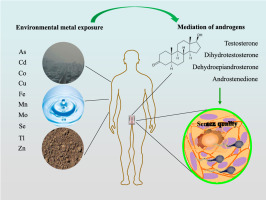Environmental Pollution ( IF 8.9 ) Pub Date : 2020-01-22 , DOI: 10.1016/j.envpol.2020.113975 Peiyi Liu 1 , Guanxiang Yuan 2 , Qi Zhou 3 , Yu Liu 3 , Xinpeng He 4 , Huimin Zhang 2 , Yinsheng Guo 5 , Ying Wen 4 , Suli Huang 5 , Yuebin Ke 4 , Jinquan Chen 4

|
As a crucial factor in male reproduction, androgens may represent an intermediate biological mechanism linking metal exposure with effects on semen quality. This study aimed to investigate the association between metal exposure and semen quality, and to assess the mediating role of seminal androgens between metal exposure and semen quality. We investigated the presence of 10 metals in semen and assessed their effect on semen quality in 1136 men recruited from a hospital in Shenzhen, China. Of these, 464 subjects were randomly selected for 4 androgens detection in semen. Cross-sectional associations between single/multiple metals, androgen levels and semen quality were explored by multivariable linear regressions. Mediation analysis was performed to detect the role of seminal androgens on the association between metal exposure and semen quality. Seminal selenium and iron were positively associated with both sperm concentration and total sperm count. Negative associations were observed between both manganese and zinc and sperm concentration, molybdenum and total sperm count, copper and sperm motility. Furthermore, we found significant dose-dependent relationships between both iron and selenium levels and dihydrotestosterone (DHT), arsenic levels and testosterone, as well as zinc and dehydroepiandrosterone. Mediation analysis indicated that higher seminal iron and selenium were associated with an increasing sperm concentration after controlling for DHT, with 10.32% and 12.89% of these associations were mediated by DHT, respectively. A similar mediation effect of DHT was observed in the associations between iron and selenium levels and total sperm count (13.39% and 21.57% mediation, respectively). Our findings suggested that the presence of selenium and iron in semen was beneficial to sperm concentration and total count. Seminal manganese, zinc, molybdenum and copper may be associated with reduced semen quality. The associations between seminal selenium and iron and sperm concentration and total count were partially explained by the concomitant variation of seminal DHT.


























 京公网安备 11010802027423号
京公网安备 11010802027423号